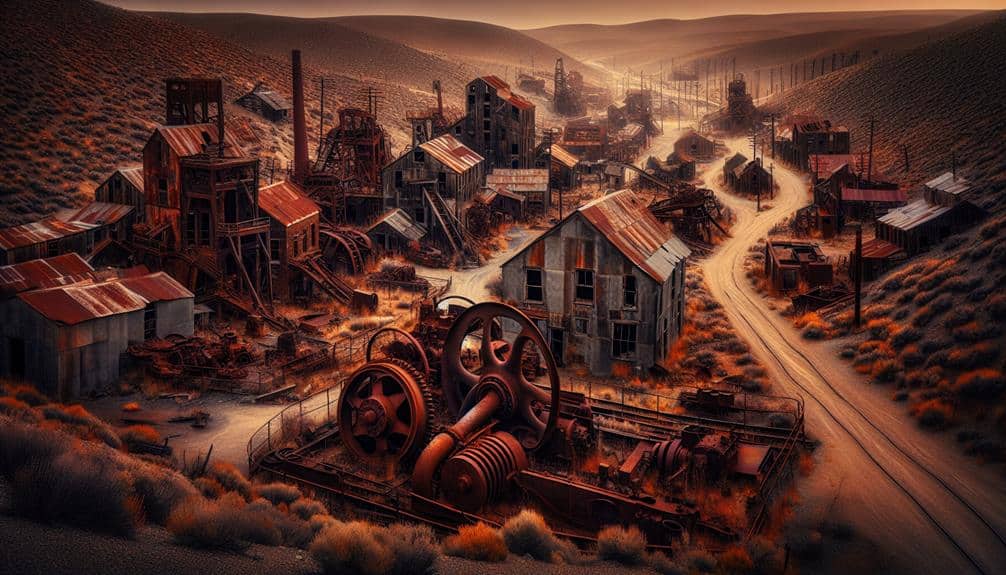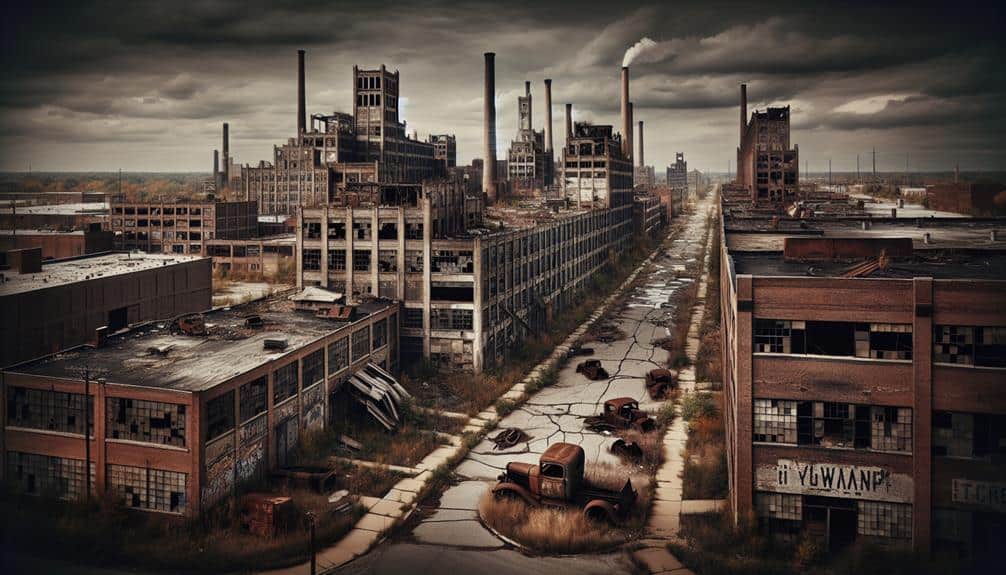Explore the remnants of forgotten U.S. mining towns, where once-thriving communities now stand as haunting witnesses to the rise and fall of industrial prosperity. From the Gold Rush towns of California to the Silver Mining towns of Nevada, each abandoned street and decaying building speaks volumes about the boom and bust cycles that shaped American history. Copper communities in Arizona, coal towns in West Virginia, and iron ore towns in Michigan all bear the scars of economic fluctuations and the resilience of their residents. Discover the hidden stories of these ghostly settlements and the echoes of their past glories.
Key Points
- Mining towns experienced rapid growth and decline due to industrial booms and busts.
- Economic prosperity driven by mining operations shaped the communities.
- Market fluctuations and resource depletion led to the downfall of many mining towns.
- Remnants of these towns serve as reminders of the transient nature of mining-based economies.
- The resilience and adaptability of these communities highlight the challenges they faced during industrial shifts.
Gold Rush Towns in California
During the mid-19th century, California's Gold Rush towns emerged as bustling hubs of activity and opportunity, drawing in prospectors from far and wide in search of their fortunes. The legacy of these towns lives on through the ghost town remnants scattered throughout the state. These remnants serve as poignant reminders of a bygone era, where dreams of striking it rich drove individuals to brave the harsh conditions of mining life.
The historical significance of these Gold Rush towns lies in their role in shaping the development of California and the United States as a whole. They were instrumental in fueling westward expansion, spurring infrastructure growth, and contributing to the cultural tapestry of the American frontier.
Exploring these ghost town remnants allows you to connect with the past, offering a glimpse into the struggles and triumphs of those who sought their fortunes in the rugged landscapes of California. As you wander through these historical sites, you can't help but feel a sense of awe at the resilience and tenacity of the individuals who once called these towns home.
Silver Mining Towns in Nevada
Nevada's silver mining towns played an essential role in shaping the economic landscape of the American West during the late 19th and early 20th centuries. The silver rush prosperity attracted a wave of fortune seekers, leading to the rapid development of towns such as Virginia City, Austin, and Pioche. These towns boomed with activity as miners extracted valuable silver ore from the ground, fueling economic growth and population influxes. However, as the silver veins were depleted and market prices fluctuated, many of these once-thriving communities faced a rapid decline, eventually becoming ghost town ruins that stand as a proof to the transient nature of mining-based economies.
Exploring these silver mining towns today offers a glimpse into the past, where remnants of once bustling streets and grand buildings now lay in disrepair. The ghost town ruins serve as a poignant reminder of the highs and lows of the mining industry, highlighting the boom and bust cycles that characterized the American West during this era.
Copper Communities in Arizona
The rich history of mining towns extends beyond Nevada's silver rush era to the vibrant copper communities nestled in the rugged landscapes of Arizona. Copper prices have long played a pivotal role in shaping the fortunes of these towns. When copper prices soared, prosperity abounded, leading to bustling communities with a strong sense of identity and purpose. However, fluctuations in copper prices often brought about periods of uncertainty and economic downturns, testing the resilience of these communities.
Mining regulations have also profoundly impacted the trajectory of copper communities in Arizona. Striking a balance between environmental preservation and economic growth has been a constant challenge. Stringent regulations aimed at protecting the environment have sometimes clashed with the interests of mining companies and local residents reliant on the industry for their livelihoods.
Despite the challenges posed by varying copper prices and evolving mining regulations, the copper communities in Arizona have persevered, embodying the spirit of resilience and adaptability that defines America's mining towns.
Coal Towns in West Virginia
Exploring the coal towns of West Virginia reveals a complex tapestry of industrial heritage and community resilience shaped by the ebb and flow of mining fortunes. Nestled in the heart of the Appalachian Mountains, these towns stand as demonstrations to a bygone era of coal mining that once thrived in this rugged region. The Appalachian heritage runs deep here, with traditions passed down through generations, reflecting a unique way of life shaped by the coal industry.
Despite the challenges of rural isolation, these communities have shown remarkable strength in the face of economic downturns and shifting energy markets. The coal towns of West Virginia have weathered booms and busts, adapting to changing circumstances while holding onto their roots. While some may see these towns as forgotten relics of the past, they remain vibrant centers of culture and history, offering a glimpse into a world shaped by coal mining. In the midst of rugged landscapes and rolling hills, the spirit of these coal towns endures, a demonstration to the resilience of the people who call this place home.
Iron Ore Towns in Michigan
Nestled within the picturesque landscapes of Michigan lie the iron ore towns, once bustling hubs of industrial activity and community life. These towns bear a rich mining legacy that shaped the region's history and economy.
- Historical Significance: Iron ore mining played a pivotal role in Michigan's development, attracting settlers and fostering growth in the 19th and early 20th centuries.
- Boom and Bust Cycles: The iron ore towns experienced fluctuations in prosperity, with periods of economic boom followed by decline as global market demands shifted.
- Community Resilience: Despite economic challenges, residents of these towns showcased resilience, fostering a strong sense of community and solidarity.
- Adaptation and Revitalization Efforts: In recent years, efforts have been made to revitalize these towns through tourism, heritage preservation, and diversification of local economies.
The iron ore towns in Michigan stand as a proof to the enduring spirit of communities shaped by the rise and fall of industrial fortunes, where the echoes of past prosperity mingle with the resilience of those who call these places home.
Frequently Asked Questions
What Were the Main Factors That Led to the Decline of These Mining Towns?
Labor conditions in mining towns deteriorated due to dangerous work environments and low wages. Economic diversification was limited, leaving these communities vulnerable to downturns in the mining industry, leading to their eventual decline.
How Did the Residents of These Towns Cope With the Economic Hardships After the Mines Closed?
When the mines closed, residents in these towns showed incredible community resilience. They diversified their economies, tapping into new industries and skills. By adapting and working together, they turned economic hardships into opportunities for growth and renewal.
What Impact Did the Closure of the Mines Have on the Surrounding Environment and Wildlife?
As the mines closed, the surrounding environment suffered. Wildlife habitats were disrupted, and ecosystems were harmed. But with sustainable development and ecological restoration efforts, the land slowly healed, offering a glimmer of hope for wildlife preservation.
Are There Any Efforts Being Made to Preserve the History and Heritage of These Forgotten Mining Towns?
Preservation efforts for these mining towns involve community engagement to honor their history and heritage. By working together, locals and enthusiasts are ensuring that the stories and legacies of these towns live on for future generations.
What Role Did the Government Play in the Rise and Fall of These Mining Communities?
You might think the government was a pillar in mining town success, but alas, its heavy hand often dictated the fate of these communities. Government intervention and lack of community support marked their rise and fall.



